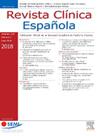Incidencia de embolia pulmonar relacionada con el embarazo en España 2016-2021: un estudio observacional retrospectivo de base poblacional
IF 1.7
4区 医学
Q2 MEDICINE, GENERAL & INTERNAL
引用次数: 0
Abstract
Objective
This study aimed to estimate the overall and annual age-standardized incidence of pregnancy-related pulmonary embolism (PE) in Spain from 2016 to 2021, explore the distribution of PE events during pregnancy and the postpartum period, identify potential risk factors, and estimate mortality rates during hospital admission.
Methods
In a retrospective, observational, population-based study, data from the Spanish National Hospital Discharge Database were analyzed to identify women with hospital episodes of pregnancy-related-PE. The primary outcome was the overall and annual age-standardized incidence of pregnancy-related-PE, with secondary aims including the distribution of events during pregnancy and postpartum and the calculation of age-standardized mortality rates during admission.
Results
Among 2,178,805 births from 2016-2021, 522 women were diagnosed with pregnancy-related PE, yielding an overall age-standardized incidence of 2.83 cases per 10,000 births. A non-significant increasing trend was observed from 2.43 to 4.18 cases per 10,000 births (P=.06). Comorbidities were low, with a notable association between PE and SARS-CoV-2 infection during the last two years. The mortality rate among women with pregnancy-related PE was 2.8%, with a higher incidence of PE reported during the postpartum period.
Conclusion
The incidence of pregnancy-related-PE in Spain exhibits a non-significant increasing trend, with a significant risk of mortality. The association with SARS-CoV-2 infection underscores the importance of vigilant monitoring and management of pregnant women, particularly during pandemics. This study contributes specific data on the incidence and characteristics of pregnancy-related-PE in Spain, emphasizing the need to consider PE in the differential diagnosis and management strategies for pregnant and postpartum women.
2016-2021 年西班牙与妊娠相关的肺栓塞发病率:基于人群的回顾性观察研究。
本研究旨在估算2016年至2021年西班牙妊娠相关肺栓塞(PE)的总发病率和年度年龄标准化发病率,探讨妊娠期和产后PE事件的分布情况,确定潜在的风险因素,并估算入院期间的死亡率。方法在一项基于人群的回顾性观察研究中,分析了西班牙国家医院出院数据库的数据,以确定妊娠相关PE住院发作的妇女。主要结果是妊娠相关 PE 的总发病率和年度年龄标准化发病率,次要目的包括孕期和产后事件的分布以及入院期间年龄标准化死亡率的计算。结果在 2016-2021 年间的 2178805 名新生儿中,有 522 名妇女被诊断为妊娠相关 PE,总年龄标准化发病率为每万名新生儿 2.83 例。从每万名新生儿 2.43 例到 4.18 例,呈非显著上升趋势(P=.06)。合并症较少,但 PE 与最近两年感染 SARS-CoV-2 有明显关联。与妊娠有关的 PE 的死亡率为 2.8%,产后 PE 的发病率较高。与 SARS-CoV-2 感染的关联强调了对孕妇进行警惕性监测和管理的重要性,尤其是在流行病期间。这项研究提供了西班牙与妊娠有关的 PE 发病率和特征的具体数据,强调了在对孕妇和产后妇女进行鉴别诊断和管理策略时考虑 PE 的必要性。
本文章由计算机程序翻译,如有差异,请以英文原文为准。
求助全文
约1分钟内获得全文
求助全文
来源期刊

Revista clinica espanola
医学-医学:内科
CiteScore
4.40
自引率
6.90%
发文量
73
审稿时长
28 days
期刊介绍:
Revista Clínica Española published its first issue in 1940 and is the body of expression of the Spanish Society of Internal Medicine (SEMI).
The journal fully endorses the goals of updating knowledge and facilitating the acquisition of key developments in internal medicine applied to clinical practice. Revista Clínica Española is subject to a thorough double blind review of the received articles written in Spanish or English. Nine issues are published each year, including mostly originals, reviews and consensus documents.
 求助内容:
求助内容: 应助结果提醒方式:
应助结果提醒方式:


